AudioCodes 450HD operation manual

AudioCodes 400HD Series of High Definition IP Phones
|
|
|
|
|
|
|
HD VoIP |
450HD IP Phone |
|
|
|
User’s Manual
450HD IP Phone for Microsoft® Skype™ for Business
Version 3.0.1

User's Manual Contents
|
|
|
Table of Contents |
|
1 |
Introduction ............................................................................................................... |
11 |
||
|
1.1 |
Highlights ......................................................................................................................... |
11 |
|
|
1.2 |
Unified Communications.................................................................................................. |
11 |
|
|
1.3 |
Management.................................................................................................................... |
11 |
|
2 Setting up the Phone................................................................................................. |
13 |
|||
|
2.1 |
Unpacking........................................................................................................................ |
13 |
|
|
2.2 |
Device Description........................................................................................................... |
14 |
|
|
|
2.2.1 |
Front View.......................................................................................................................... |
14 |
|
|
2.2.2 |
Rear View .......................................................................................................................... |
16 |
|
2.3 |
Cabling............................................................................................................................. |
17 |
|
|
2.4 |
Mounting the Phone......................................................................................................... |
18 |
|
|
|
2.4.1 |
Desktop Mounting.............................................................................................................. |
18 |
|
|
|
2.4.1.1 Routing the Handset Cable ................................................................................ |
18 |
|
|
2.4.2 |
Wall Mounting .................................................................................................................... |
19 |
3 |
Getting Started........................................................................................................... |
21 |
||
|
3.1 |
Getting Acquainted with the Phone's Touch Screen........................................................ |
21 |
|
|
3.2 |
Softkeys ........................................................................................................................... |
22 |
|
|
3.3 |
Navigating the Phone Menu ............................................................................................ |
23 |
|
|
3.4 |
Selecting an Alphanumerical Mode ................................................................................. |
25 |
|
|
3.5 |
Signing In......................................................................................................................... |
27 |
|
|
|
3.5.1 Signing in with PIN Code ................................................................................................... |
27 |
|
|
|
3.5.2 Signing in with User Name and Password ........................................................................ |
28 |
|
|
|
3.5.3 Signing in with the Cloud PBX Web Option....................................................................... |
29 |
|
|
3.6 |
Signing Out ...................................................................................................................... |
29 |
|
|
|
3.6.1 Signing out if the 'Sign out' Softkey is Removed from the Touch Screen ......................... |
31 |
|
|
3.7 |
Displayed Messages........................................................................................................ |
34 |
|
4 Unlocking a Locked Phone....................................................................................... |
35 |
|||
5 |
Customizing Your Phone.......................................................................................... |
37 |
||
|
5.1 |
Changing the Screen Language ...................................................................................... |
37 |
|
|
5.2 |
Selecting Ring Tone ........................................................................................................ |
38 |
|
|
5.3 |
Enabling Call Waiting....................................................................................................... |
39 |
|
|
5.4 |
Managing Simultaneous Incoming Calls.......................................................................... |
39 |
|
|
|
5.4.1 Configuring Busy on Busy ................................................................................................. |
40 |
|
|
5.5 |
Configuring Call Forwarding ............................................................................................ |
41 |
|
|
5.6 |
Setting Date and Time ..................................................................................................... |
42 |
|
|
5.7 |
Configuring Screen Brightness ........................................................................................ |
44 |
|
|
5.8 |
Selecting an Answering Device ....................................................................................... |
46 |
|
|
5.9 |
Configuring Location........................................................................................................ |
47 |
|
|
5.10 |
Uploading Logs to Microsoft Server................................................................................. |
48 |
|
|
5.11 |
Configuring an Outbound Proxy ...................................................................................... |
49 |
|
|
5.12 |
Adjusting Volume............................................................................................................. |
50 |
|
|
|
5.12.1 |
Adjusting Ring Volume ...................................................................................................... |
50 |
|
|
5.12.2 |
Adjusting Tones Volume.................................................................................................... |
50 |
|
|
5.12.3 |
Adjusting Handset Volume ................................................................................................ |
51 |
|
|
5.12.4 |
Adjusting Speaker Volume ................................................................................................ |
51 |
|
|
5.12.5 |
Adjusting Headset Volume ................................................................................................ |
52 |
|
5.13 |
Managing Phone Directories ........................................................................................... |
53 |
|
|
|
5.13.1 |
Accessing Directories ........................................................................................................ |
53 |
Version 3.0.1 |
3 |
450HD IP Phone |

|
|
|
|
450HD IP Phone |
|
|
|
5.13.2 |
Adding a Contact to the Personal Directory ...................................................................... |
|
54 |
|
|
5.13.3 |
Editing Contact Information in the Personal Directory....................................................... |
|
56 |
|
|
5.13.4 |
Deleting a Contact from the Personal Directory ................................................................ |
|
57 |
|
|
5.13.5 |
Adding a Person to Favorites after a Call with them is Logged......................................... |
|
58 |
|
|
5.13.6 |
Removing a Person from Favorites ................................................................................... |
|
59 |
|
|
5.13.7 |
Searching for a Contact in a Directory............................................................................... |
|
60 |
|
5.14 |
Searching for a Contact in the Corporate Directory using T9 .......................................... |
|
61 |
|
|
|
5.14.1 |
Searching for a Contact Using A/a/1 Instead of T9 ........................................................... |
|
62 |
|
5.15 |
Configuring a Function Key as a Speed Dial ................................................................... |
|
63 |
|
|
5.16 |
Configuring a Function Key as Speed Dial+BLF ............................................................. |
|
65 |
|
|
|
5.16.1 |
Configuring Pause Dialing for a Speed Dial to an Ext. behind an IVR .............................. |
66 |
|
|
|
5.16.2 |
Deleting a Speed Dial ........................................................................................................ |
|
66 |
|
5.17 |
Configuring a Function Key as a Key Event .................................................................... |
|
67 |
|
|
|
5.17.1 |
Configuring a Function Key as a VocaNOM Speed Dial ................................................... |
|
69 |
|
|
5.17.2 |
Deleting a Key Event ......................................................................................................... |
|
70 |
|
5.18 |
Changing your Presence Status ...................................................................................... |
|
71 |
|
|
5.19 |
Viewing Microsoft Exchange Calendar in the Phone's Touch Screen ............................. |
73 |
||
|
5.20 |
Receiving Meeting Reminders......................................................................................... |
|
74 |
|
|
5.21 |
Determining Meeting Attendees' Presence Status .......................................................... |
|
75 |
|
6 |
Performing Basic Operations................................................................................... |
|
77 |
||
|
6.1 |
Using Audio Devices........................................................................................................ |
|
77 |
|
|
6.2 |
Making Calls .................................................................................................................... |
|
77 |
|
|
|
6.2.1 |
Dialing ................................................................................................................................ |
|
78 |
|
|
6.2.2 |
Redialing ............................................................................................................................ |
|
79 |
|
|
6.2.3 |
Dialing a Missed Call ......................................................................................................... |
|
80 |
|
6.3 |
Answering Calls ............................................................................................................... |
|
81 |
|
|
6.4 |
Rejecting Incoming Calls ................................................................................................. |
|
82 |
|
|
6.5 |
Silencing Incoming Calls.................................................................................................. |
|
83 |
|
|
6.6 |
Ending an Established Call.............................................................................................. |
|
83 |
|
|
6.7 |
Viewing Missed, Received and Dialed Calls.................................................................... |
|
84 |
|
7 |
Performing Advanced Operations ........................................................................... |
|
87 |
||
|
7.1 |
Answering Waiting Calls .................................................................................................. |
|
87 |
|
|
7.2 |
Placing Calls On Hold...................................................................................................... |
|
89 |
|
|
7.3 |
Handling Multiple Incoming Calls..................................................................................... |
|
89 |
|
|
7.4 |
Using a Speed Dial to Call............................................................................................... |
|
90 |
|
|
7.5 |
Transferring Calls ............................................................................................................ |
|
91 |
|
|
|
7.5.1 |
Performing a Blind Transfer............................................................................................... |
|
91 |
|
|
7.5.2 |
Performing a Consultative Transfer ................................................................................... |
|
93 |
|
|
7.5.3 |
Performing a Semi-Consultative Transfer.......................................................................... |
|
94 |
|
|
7.5.4 |
Merging Calls ..................................................................................................................... |
|
95 |
|
7.6 |
Parking a Call .................................................................................................................. |
|
96 |
|
|
7.7 |
Configuring Group Call Pickup (GCP) ............................................................................. |
|
97 |
|
|
7.8 |
Initiating a Multi-Party Skype for Business Remote Conference ..................................... |
|
97 |
|
|
7.9 |
Muting Calls ................................................................................................................... |
|
102 |
|
|
7.10 |
Setting up Better Together over Ethernet ...................................................................... |
|
103 |
|
|
|
7.10.1 |
Installing the BToE PC/Laptop Application...................................................................... |
|
103 |
|
|
7.10.2 |
Making Sure BToE is Correctly Installed ......................................................................... |
|
111 |
|
|
7.10.3 |
Configuring the BToE TCP Port....................................................................................... |
|
111 |
|
|
7.10.4 |
Enabling BToE for Online Users...................................................................................... |
|
112 |
|
|
7.10.5 |
Automatically Pairing the BToE PC/Laptop Application with the Phone ......................... |
112 |
|
|
|
7.10.6 |
Manually Pairing the BToE PC/Laptop Application with the Phone ................................ |
113 |
|
|
|
|
7.10.6.1 Manually Generating a Pair Code .................................................................... |
|
113 |
|
|
|
7.10.6.2 Manually Connecting the Phone with the BToE PC/Laptop Application.......... |
114 |
|
|
|
|
|||
User's Manual |
4 |
Document #: LTRT-14820 |
|||

User's Manual |
Contents |
7.10.6.3 Connecting the Skype for Business Client with the Phone |
..............................117 |
7.10.7 Making Sure the Phone/ Skype for Business Client are Paired ...................................... |
117 |
7.10.7.1 Making Sure Skype for Business Client is Paired ............................................ |
117 |
7.10.7.2 Making Sure the Phone is Paired..................................................................... |
118 |
7.11 Using BToE Functions ................................................................................................... |
119 |
7.11.1 Signing in to the Phone from the Skype for Business Client ........................................... |
119 |
7.11.2 Making a Call (Click-to-Dial) ............................................................................................ |
120 |
7.11.3 Answering a Call .............................................................................................................. |
120 |
7.11.4 Establishing a Unified Communications Call Conference ............................................... |
121 |
7.11.5 Transferring a Call ........................................................................................................... |
123 |
7.11.6 Switching the Primary Audio Device................................................................................ |
123 |
7.11.7 Routing Voice from a Video Call to the Phone ................................................................ |
125 |
7.12 Viewing and Playing Voicemail Messages .................................................................... |
126 |
7.12.1 Sending an Incoming Call Directly to Voicemail .............................................................. |
127 |
8 Troubleshooting ...................................................................................................... |
129 |
8.1 Uploading Logs to Microsoft Server for Support Purposes............................................ |
130 |
Version 3.0.1 |
5 |
450HD IP Phone |

|
450HD IP Phone |
List of Figures |
|
Figure 2-1: Front View ...................................................................................................................................... |
14 |
Figure 2-2: Rear View....................................................................................................................................... |
16 |
Figure 2-3: Cabling ........................................................................................................................................... |
17 |
Figure 3-1: Touch Screen in Idle State............................................................................................................. |
21 |
Figure 3-2: Menu Screen.................................................................................................................................. |
23 |
Figure 3-3: Menus............................................................................................................................................. |
24 |
Figure 3-4: Alphanumerical Selection............................................................................................................... |
25 |
Figure 3-5: Entering a Symbol (e.g., a dot) ...................................................................................................... |
26 |
Figure 3-6: Reverting to Letters (e.g., abc) ...................................................................................................... |
26 |
Figure 3-7: Login............................................................................................................................................... |
31 |
Figure 3-8: Web Interface – Home Page.......................................................................................................... |
31 |
Figure 3-9: Sign-in – Content Blocked Page .................................................................................................... |
32 |
Figure 3-10: Sign-in – Windows Security Prompt............................................................................................. |
32 |
Figure 3-11: Windows Security Prompt............................................................................................................ |
33 |
Figure 3-12: Sign-out........................................................................................................................................ |
33 |
Figure 7-1: InstallShield Wizard – Preparing to Install ................................................................................... |
104 |
Figure 7-2: Welcome to the InstallShield Wizard ........................................................................................... |
104 |
Figure 7-3: License Agreement ...................................................................................................................... |
105 |
Figure 7-4: License Agreement ...................................................................................................................... |
105 |
Figure 7-5: Destination Folder ........................................................................................................................ |
106 |
Figure 7-6: Change Current Destination Folder ............................................................................................. |
106 |
Figure 7-7: Ready to Install ............................................................................................................................ |
107 |
Figure 7-8: Installing AudioCodes Better2Gether........................................................................................... |
107 |
Figure 7-9: InstallShield Wizard Completed ................................................................................................... |
108 |
Figure 7-10: AudioCodes Icon in Taskbar...................................................................................................... |
108 |
Figure 7-11: Control Panel>Programs>AudioCodes Better2Gether .............................................................. |
109 |
Figure 7-12: Computer Management > Services and Applications................................................................ |
109 |
Figure 7-13: Device Manager > AudioCodes B2GoE USB Driver ................................................................. |
110 |
Figure 7-14: Popup Menu............................................................................................................................... |
111 |
Figure 7-15: About AC BToE.......................................................................................................................... |
111 |
Figure 7-16: TCP Port..................................................................................................................................... |
111 |
Figure 7-17: AC BToE TCP Port .................................................................................................................... |
112 |
Figure 7-18: Popup Menu............................................................................................................................... |
114 |
Figure 7-19: Phone Pairing............................................................................................................................. |
114 |
Figure 7-20: AC BToE Failed Indication......................................................................................................... |
114 |
Figure 7-21: AC BToE is Connected Indication.............................................................................................. |
114 |
Figure 7-22: Popup Menu: 'Disconnect' Enabled, 'Phone Pairing' Disabled .................................................. |
115 |
Figure 7-23: BToE Disconnected ................................................................................................................... |
115 |
Figure 7-24: Popup Menu: BToE Disconnected............................................................................................. |
115 |
Figure 7-25: Start > Programs > AudioCodes > BToE Controller .................................................................. |
116 |
Figure 7-26: Skype for Business Sign-in Request Prompt............................................................................. |
117 |
Figure 7-27: Primary Device: Phone .............................................................................................................. |
123 |
Figure 7-28: Primary Device: Speaker ........................................................................................................... |
124 |
Figure 7-29: Primary Device: Headset ........................................................................................................... |
124 |
User's Manual |
6 |
Document #: LTRT-14820 |

User's Manual |
Contents |
List of Tables |
|
Table 2-1: Font View Description ..................................................................................................................... |
14 |
Table 2-2: Rear View Description..................................................................................................................... |
16 |
Table 3-1: Touch Screen in Idle State .............................................................................................................. |
21 |
Table 3-2: Softkey Descriptions........................................................................................................................ |
22 |
Table 3-3: Menu Descriptions........................................................................................................................... |
23 |
Table 3-4: Displayed Messages Indicating Processes In Progress ................................................................. |
34 |
Table 5-1: Time Zones...................................................................................................................................... |
43 |
Table 5-2: Screen Brightness Options.............................................................................................................. |
44 |
Table 5-3: Presence Statuses .......................................................................................................................... |
71 |
Table 5-4: Meeting Status ................................................................................................................................ |
74 |
Table 8-1: Troubleshooting............................................................................................................................. |
129 |
Version 3.0.1 |
7 |
450HD IP Phone |

450HD IP Phone
This page is intentionally left blank.
User's Manual |
8 |
Document #: LTRT-14820 |

User's Manual |
Notices |
Notice
Information contained in this document is believed to be accurate and reliable at the time of printing. However, due to ongoing product improvements and revisions, AudioCodes cannot guarantee accuracy of printed material after the Date Published nor can it accept responsibility for errors or omissions. Updates to this document and other documents can be viewed by registered customers at http://www.audiocodes.com/downloads.
© Copyright 2017 AudioCodes Ltd. All rights reserved.
This document is subject to change without notice. Date Published: Jun-26-2017
Trademarks
AudioCodes Ltd. All rights reserved. AudioCodes, AC, HD VoIP, HD VoIP Sounds Better, IPmedia, Mediant, MediaPack, What’s Inside Matters, OSN, SmartTAP, VMAS, VoIPerfect, VoIPerfectHD, Your Gateway To VoIP, 3GX, VocaNom, AudioCodes One Voice and CloudBond are trademarks or registered trademarks of AudioCodes Limited All other products or trademarks are property of their respective owners. Product specifications are subject to change without notice.
WEEE EU Directive
Pursuant to the WEEE EU Directive, electronic and electrical waste must not be disposed of with unsorted waste. Please contact your local recycling authority for disposal of this product.
Customer Support
Customer technical support and services are provided by AudioCodes or by an authorized AudioCodes Service Partner. For more information on how to buy technical support for AudioCodes products and for contact information, please visit our Web site at www.audiocodes.com/support.
Abbreviations and Terminology
Each abbreviation, unless widely used, is spelled out in full when first used.
Documentation Feedback
AudioCodes continually strives to produce high quality documentation. If you have any comments (suggestions or errors) regarding this document, please fill out the Documentation Feedback form on our Web site at http://www.audiocodes.com/downloads. Your valuable feedback is highly appreciated.
Version 3.0.1 |
9 |
450HD IP Phone |
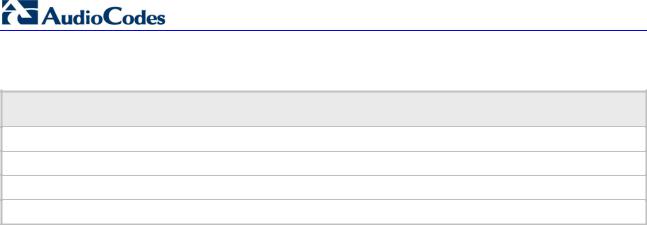
450HD IP Phone
Related Documentation
Document Name
400HD Series IP Phones for Microsoft Skype for Business Release Notes
400HD Series IP Phones for Microsoft Skype for Business Administrator’s Manual
450HD IP Phone for Microsoft Skype for Business Quick Guide
400HD Series IP Phones for Skype for Business Hosting Partner (LHPv2) Environment Configuration Note
User's Manual |
10 |
Document #: LTRT-14820 |
User's Manual |
1. Introduction |
1 Introduction
AudioCodes' 450HD IP Phone is a high-end, executive phone model delivering high-definition enterprise voice within Skype for Business unified communications environments.
The main feature differentiating this model from the other IP phone models in AudioCodes' 400HD IP Phones Series is its large (800 x 400), graphical, high-resolution, 5-inch color touch (TFT) screen with an intuitive touch-oriented user interface design. This touch screen user interface enables up to eight Function Keys with multi-lingual support.
The phone supports Gigabit Ethernet (GbE or 1 GigE). The phone also features support for two USB headsets and an expansion module is in the roadmap. Skype for Business certification is pending.
1.1Highlights
Highlighted features of the 450HD model are:
Eight lines, two concurrent calls per line
Graphical 5" high-resolution color TFT touch screen (800 x 400)
Highly intuitive, touch-oriented user interface enabling up to 8 Function softkeys and extensive unified communications functionality
Multi-lingual support
Two USB headsets, two GbE interfaces supported
Expansion module support (roadmap)
Skype for Business certification (pending)
Conferencing and multi-call management, contacts’ photos display, and more.
High-definition call quality with SILK voice coder support
Part of AudioCodes' IP phone management which defines it as an IT-managed entity.
1.2Unified Communications
Designed specially for use within unified communications environments, including Skype for Business Online, the 450HD provides built-in support for the industry’s leading voice codecs, including SILK, to offer high voice quality even under poor network conditions.
1.3Management
Along with the other members of the AudioCodes 400HD IP phone family, it can be deployed as part of a fully managed IP phone solution, with unique and complete centralized device life-cycle management courtesy of AudioCodes' IP phone management utilities for managing end-user desktop devices.
Read this User’s Manual carefully to learn how to operate the product and take full advantage of its rich feature set.
Version 3.0.1 |
11 |
450HD IP Phone |

450HD IP Phone
This page is intentionally left blank.
User's Manual |
12 |
Document #: LTRT-14820 |
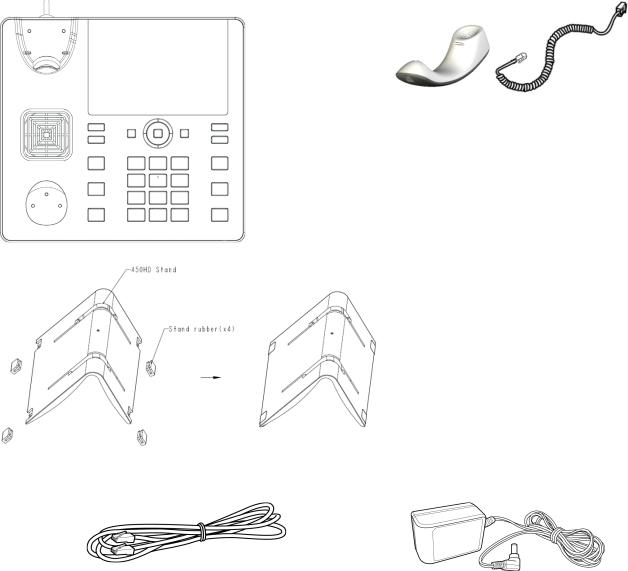
User's Manual |
2. Setting up the Phone |
2 Setting up the Phone
2.1Unpacking
When unpacking, ensure that the following items are present and undamaged:
Phone / Stand |
Handset / Cord |
Cat 5e Ethernet Cable |
AC Power Adapter (Optional) |
If anything appears to be missing or broken, contact the distributor from whom you purchased the phone for assistance.
Version 3.0.1 |
13 |
450HD IP Phone |
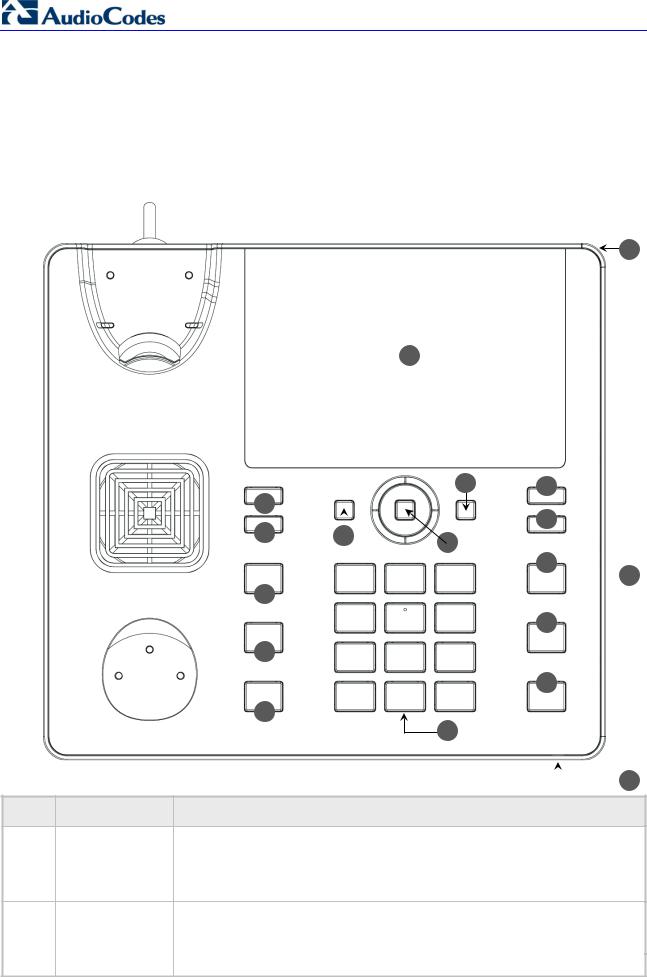
450HD IP Phone
2.2Device Description
Use the graphics below to identify and familiarize yourself with the device's hardware functions.
2.2.1Front View
The front view of the phone is shown in Figure 2-1 and described in Table 2-1.
Figure 2-1: Front View
1
2
17 |
|
|
6 |
4 |
|
|
|
|
|
5 |
|
16 |
|
|
|
|
|
18 |
3 |
|
|
||
|
|
|
|
|
|
7
 8
8
15
9
14
10
13
11
Table 2-1: Font View Description |
|
12 |
|
Item # |
Label/Name |
Description |
1 |
Ring LED |
Indicates phone status: |
Green: Idle state
Flashing blue: Incoming call (ringing)
Red: Answered call
2 |
TFT touch |
Thin Film Transistor touch screen, a type of LCD (Liquid Crystal Display) |
|
screen |
interactive screen which displays calling information and lets you configure |
|
|
phone features by touching the glass. |
3 |
Navigation |
Press the button's upper rim to scroll up menus/items in the touch screen. |
User's Manual |
14 |
Document #: LTRT-14820 |

User's Manual |
|
2. Setting up the Phone |
|||
|
|
|
|
|
|
|
Item # |
Label/Name |
|
Description |
|
|
|
|
|
|
|
|
|
Control / OK |
|
Press the button's lower rim to scroll down. |
|
|
|
|
Press the button's left or right rim to move the cursor left or right (when |
||
|
|
|
|
editing a contact number for example). |
|
|
|
|
Press OK to select a menu/item/option. |
||
4 |
Voicemail |
Retrieves voicemail messages. |
|||
5 |
CONTACTS |
Press to directly access the 'Favorites' directory. Other directories can be |
|||
|
|
|
accessed from the 'Favorites' screen. |
||
6 |
MENU |
Accesses menus: |
|||
|
|
|
|
Call Log |
|
|
|
|
|
Calendar |
|
|
|
|
|
Keys |
|
|
|
|
|
Settings |
|
|
|
|
|
Device Status |
|
|
|
|
|
Administration |
|
|
|
|
|
Favorites |
|
|
|
|
|
Log upload. |
|
|
|
|
|||
7 |
REDIAL |
Accesses a list of recently dialed numbers; one can be selected to redial. |
|||
8 |
Kensington lock |
Allows locking the device. |
|||
9 |
TRANSFER |
Transfers a call. |
|||
10 |
HOLD |
Places an active call on hold. |
|||
11Alphanumerical Keys for entering numbers, alphabetical letters and symbols (e.g., colons)
Keypad
12Microphone Allows talking and listening. The network administrator can disable it if
|
|
required. |
13 |
SPEAKER |
Activates the speakerphone, allowing a hands-free conversation. |
14 |
HEADSET |
Activates a call using an external headset. |
15 |
MUTE |
Mutes a call. |
16 |
▲ VOL |
Increases or decreases the volume of the handset, headset, speakerphone, |
17 |
▼ VOL |
ring tone and call progress tones. |
18 |
x |
Cancel an action, such as dialing a number, after beginning it. |
Version 3.0.1 |
15 |
450HD IP Phone |

450HD IP Phone
2.2.2Rear View
The rear view of the phone is shown in the figure below and described in the table below.
3 |
Figure 2-2: Rear View |
4 |
|
2
5
1
|
|
Table 2-2: Rear View Description |
|
|
|
# |
Label |
Description |
|
|
|
1 |
|
Handset jack, i.e., port RJ-9, to connect the handset. |
|
|
|
2 |
|
RJ-45 port to connect to the Ethernet LAN cable for the LAN connection |
|
(uplink - 10/100/1000 Mbps). If you're using Power over Ethernet (PoE), |
|
|
|
|
|
|
power to the phone is supplied from the Ethernet cable (draws power |
|
|
from either a spare line or a signal line). |
3 |
|
RJ-45 port to connect the phone to a PC (10/100/1000 Mbps downlink). |
|
|
|
4 |
|
12V DC power jack that connects to the AC power adapter. |
|
|
|
5 |
|
Headset jack, i.e., RJ-9 port that connects to an external headset. |
|
|
|
User's Manual |
16 |
Document #: LTRT-14820 |
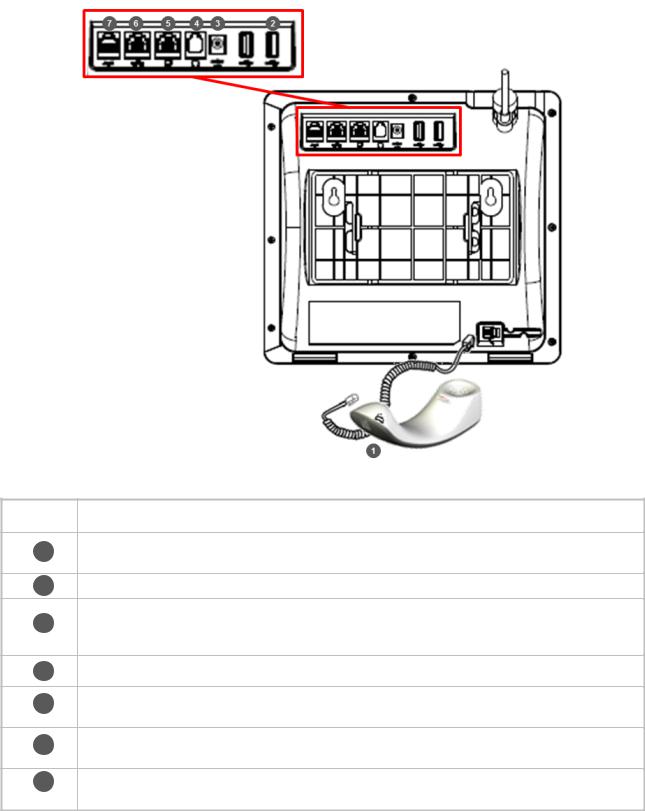
User's Manual |
2. Setting up the Phone |
2.3Cabling
This section covers how to cable your phone. Use the figure and table below as reference.
Figure 2-3: Cabling
Action |
Description |
|
|
1Connect the phone's RJ-9 port to the handset cord's longer, straight end. Connect the handset to the handset cord's short, straight end.
2Connect one of the two USB ports to a headset [optional].
Connect the phone’s power socket labelled DC 12V to the connector tip of the AC power
3adapter. Connect the two-prong AC adapter directly to the electrical wall outlet. When the phone powers up, all the LEDs momentarily light up.
4Connect the phone's RJ-9 headset jack to a headset [optional]
5Connect the RJ-45 PC port to a computer/laptop, using a CAT 5 / 5e straight-through Ethernet cable
6Connect the phone's RJ-45 LAN port to your LAN network (LAN port or LAN switch/router) using a CAT 5 / 5e Ethernet cable.
7Internal use only. FAEs use the port to debug and troubleshoot the phone - after connecting the AUX (auxiliary) port to a terminal monitor with a serial cable.
Version 3.0.1 |
17 |
450HD IP Phone |

450HD IP Phone
Note: If the LAN to which the phone is connected supports Power over Ethernet (PoE), no AC adapter is required; the phone receives power from the Ethernet network.
Prior to connecting power, refer to the Compliancy and Regulatory Information at www.audiocodes.com/library.
2.4Mounting the Phone
The phone can be mounted on a:
Desk (see Section 2.4.1 below)
Wall (see Section 2.4.2 on page 19)
See also https://www.youtube.com/watch?v=oGe9STB9lFE to assemble the base stand.
2.4.1Desktop Mounting
This section shows how to mount the phone on a flat surface like a desk.
To mount the phone on a flat surface like a desk:
1.Off-hook the handset (if on-hook) and place the phone upside down, i.e., base-up, on your desktop.
2.On the phone's stand, identify outer notches.
3.On the phone's base, identify outer rails.
4.Invert the stand and align its outer notches with the base's outer rails.
5.Insert the stand's outer notches into the base's outer rails and slide the notches along the rails until the stand click-locks into the base.
6.Revert the phone and stand it on the desktop.
2.4.1.1Routing the Handset Cable
The phone features a groove for routing the handset cable.
User's Manual |
18 |
Document #: LTRT-14820 |
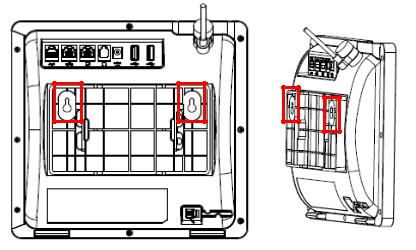
User's Manual |
2. Setting up the Phone |
2.4.2Wall Mounting
This section shows how to mount the phone on a wall.
To mount the phone on a wall:
1.Attach the stand of the phone for the purpose of a wall mounting: a. Detach the base.
b.Attach it again as you did for a desktop mounting (see Section 2.4.1 on page 18) only now make sure that it's flatly aligned to lie flush against the wall, i.e., slide the inner rails of the phone stand onto the phone base's inner notches.
2.Connect the AC power adapter, LAN and PC/laptop cords.
3.In the wall, drill two horizontal holes at a distance of 3 15/16 inches (100 mm) from one another, in line with the template.
4.Insert two masonry anchors into the holes if necessary.
5.Thread two screws (not supplied) into the two masonary anchors; ensure that the heads extend sufficiently (about 3/16 inch or 5 mm from the wall) for the phone stand's keyhole slots to hang on.
6.Hang the phone stand's keyhole slots on these screws.
Version 3.0.1 |
19 |
450HD IP Phone |

450HD IP Phone
This page is intentionally left blank.
User's Manual |
20 |
Document #: LTRT-14820 |

User's Manual |
3. Getting Started |
3 Getting Started
This section gets you started with the phone. The phone features a touch screen, providing an intuitive, menu-driven user interface for configuring the device and viewing call information.
This section shows how to use the phone’s touch screen but before using it, you must sign in.
3.1Getting Acquainted with the Phone's Touch Screen
This section gets you acquainted with the phone's touch screen.
The figure below shows the touch screen in idle state.
Figure 3-1: Touch Screen in Idle State
Reference:
|
|
|
|
Table 3-1: Touch Screen in Idle State |
|
|
|
|
|
Reference |
|
Description |
||
|
|
|
|
|
|
|
|
|
Presence status (Available, Busy, Do not disturb, Away, or Be right back). |
|
|
|
|
See Section 5.18 on page 71 for details. |
|
|
|
|
|
|
|
|
|
User name and phone number configured by your network administrator using the Web |
|
|
|
|
|
|
|
|
|
interface. |
|
|
|
|
|
|
|
|
|
Softkeys; to activate a softkey, touch its icon located in the screen. |
|
|
|
|
|
|
|
|
|
See Table 3-2 for softkey descriptions. |
|
|
|
|
|
|
|
|
|
|
|
|
|
|
Day, Date and Month, automatically retrieved from the Network Time Protocol (NTP) |
|
|
|
|
server, enabled by your network administrator. |
|
|
|
|
|
|
|
|
|
Time, automatically retrieved from the Network Time Protocol (NTP) server, enabled by |
|
|
|
|
|
|
|
|
|
your network administrator. |
|
|
|
|
|
|
|
|
|
Softkeys (see the next page). |
|
|
|
|
|
|
|
|
|
|
Version 3.0.1 |
21 |
450HD IP Phone |

450HD IP Phone
3.2Softkeys
The table below describes the softkeys displayed in the touch screen. Touch a softkey to activate.
|
Table 3-2: Softkey Descriptions |
|
|
|
|
Softkey |
Description |
|
|
|
|
Meet Now |
Initiates a Skype for Business server based phone conference. |
|
|
|
|
Missed |
Displays missed calls. |
|
|
|
|
Forward |
Automatically forwards calls. |
|
|
|
|
Status |
Lets you sets your presence status: Available, Busy, Do not disturb, Away, Be right back. |
|
|
|
|
Sign in |
Sign in is displayed if you haven't signed in yet, in the idle screen. |
|
/Sign out |
Sign out is displayed if you touch the Status softkey after signing in. |
|
Directory |
Displayed after lifting the handset (for example). Allows access to the Corporate or Personal |
|
|
Directory. |
|
|
|
|
Call Log |
Displayed after lifting the handset (for example). Allows access to the Call Logs. |
|
|
|
|
Select |
Identical to the hard OK key on the phone. Either can be used. Selects a menu or option. |
|
|
|
|
BToE |
Displayed after pressing the MENU hard key. Generates a code for manually pairing the |
|
|
phone with Skype for Business client, for unified communications. |
|
A/a/1 |
Displayed to allow switching between abc, ABC, Abc, 123, or T9 when inputting. |
|
|
|
|
Save |
Saves settings. Displayed after pressing Forward > Forward to a number and then entering |
|
|
the number to which to forward to (for example). |
|
Cancel |
Cancels the currently initiated call or configuration. |
|
|
|
|
Dial |
Displayed after a number is keyed, a directory contact is selected, or a logged call is |
|
|
selected. |
|
Clear |
Displayed after entering a digit of a phone number (for example). Deletes from right to left. |
|
|
|
|
Call Menu |
Displayed after a number is dialed and answered on the other side, and after you answer a |
|
|
call. Displays the Call Menu. |
|
Conference |
Displayed (1) after a number is dialed and the call is answered on the other side and (2) |
|
|
after you answer a call. Touching the softkey opens the ADD PARTICIPANT screen. |
|
|
|
|
BXfer |
Displayed (1) after a number is dialed and the call is answered on the other side and (2) |
|
|
after a call is answered. Lets you transfer the call in a blind transfer. |
|
URL |
Displayed after lifting the handset (for example). Enables calling a URL. |
|
|
|
|
Detail |
Displayed after selecting a call log (for example). If selected, the details of a logged call are |
|
|
displayed (Time, Date, etc.). |
|
Favorite |
Displayed in the Call Details screen. Allows adding the person to the Favorites directory. |
|
|
|
|
End |
Displayed after pressing the Dial softkey (for example). Ends the call. |
|
|
|
|
Back |
Displayed after pressing the MENU hard key (for example). Returns to the previous screen. |
|
|
|
|
Edit |
Displayed after you select a contact to be edited (for example). |
|
|
|
|
Delete |
Displayed after pressing the MENU hard key on the phone and then selecting Call Log (for |
|
|
example). |
|
Silent |
Displayed when the phone rings on an incoming call. Lets you silence the ring. |
|
|
|
|
Reject |
Displayed when the phone rings, alerting to an incoming call. Lets you reject the call. |
|
|
|
|
Accept |
Displayed when the phone rings, alerting to an incoming call. Lets you accept the call. |
|
|
|
|
|
|
|
User's Manual |
22 |
Document #: LTRT-14820 |

User's Manual |
3. Getting Started |
3.3Navigating the Phone Menu
The MENU hard key on the phone lets you configure settings and access information. Press the key to view the phone's Menu screen.
Figure 3-2: Menu Screen
Touch a menu to perform actions described in the table below (from left to right).
|
Table 3-3: Menu Descriptions |
|
|
Menu |
Description |
|
|
Call Log |
Accesses logged calls (All Calls, Missed Calls, Received Calls and Dialed Calls) |
|
|
Favorites |
Accesses the 'Favorites' directory. |
|
|
Keys |
Used to configure Function Keys as Speed Dial, Speed Dial+BLF, Key Event, or |
|
VocaNOM. |
Settings |
Used to customize phone settings and upload logs to Microsoft server. |
|
|
Administration |
Used to perform administrative tasks such as configure network settings, restore |
|
defaults and restart. |
Device Status |
Used to obtain information about the device's network status, firmware version, release |
|
and location. |
BToE |
Used to set up unified communications between the phone and your pc/laptop based |
|
Skype for Business client. |
Calendar |
Used to view meetings scheduled in the calendar for that day (integrated with Skype |
|
for Business client). |
Version 3.0.1 |
23 |
450HD IP Phone |

450HD IP Phone
The figure below shows the phone's menus.
Figure 3-3: Menus
Call Log
All Calls
Missed Calls
Received Calls
Dialed Calls
Favorites
Keys
Function Keys
Settings
Language
Ring Tone
Call Waiting
Forward settings
Date and Time
LCD Brightness
Answer Device
Location
Log Upload
Outbound Proxy
Device Security
Administration
Device Status
Network Status
Firmware Version
Release Information
Location Information
BToE
Calendar
Note: Administration is intended for network administrators only. It is password protected. See the Administrator’s Manual for details.
|
To navigate to a menu item: |
|
Press the navigation control button's upper, lower, left or right rim, or press the item's |
|
number, e.g., open the Settings menu and press 4 to navigate to Forward Settings. |
|
To select a menu item: |
Press the navigation control's OK button or touch the item.
To cancel and move to a previous menu level:
Touch the Back softkey.
User's Manual |
24 |
Document #: LTRT-14820 |
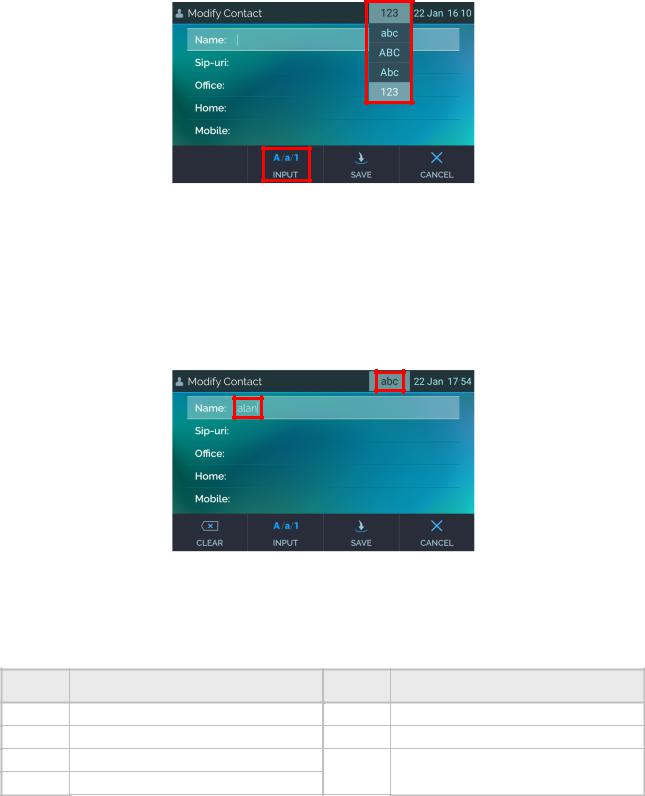
User's Manual |
3. Getting Started |
3.4Selecting an Alphanumerical Mode
The keypad lets you enter alphabetical letters, numbers or symbols, and to switch between them.
To select a number, letter or symbol (e.g., lower case letters):
1.When configuring a contact, for example, touch the A/a/1 softkey:
Figure 3-4: Alphanumerical Selection
You can also access the mode menu by pressing the # key on the keypad. Successively press the # key to navigate in the mode menu.
2.From the mode menu, navigate to and select:
•abc = lower case letters
•ABC = upper-case letters
•Abc = first-letter upper case, the rest lower case
•123 = numerical mode (i.e., numbers)
3.Select abc (for example) and then on the keypad, press 2 (for example); a is entered. Successively press 5 three times; l is entered (pressing it once produces j, twice produces k). Similarly, enter a and finally n.
To enter a symbol (e.g., dot or @ or hyphen):
1.Touch the A/a/1 softkey and navigate to abc (mandatory).
2.Press the 1 key on the keypad; a period / full stop is entered. Immediately press the 1 key again; a backslash is entered.
3.Pressing successively produces the following symbols:
Symbol Explanation
. Dot
\Backslash
@At
;Semi-colon
Symbol Explanation
* Star sign
=Equal sign
| |
Separator |
|
|
( |
Open parenthesis |
Version 3.0.1 |
25 |
450HD IP Phone |
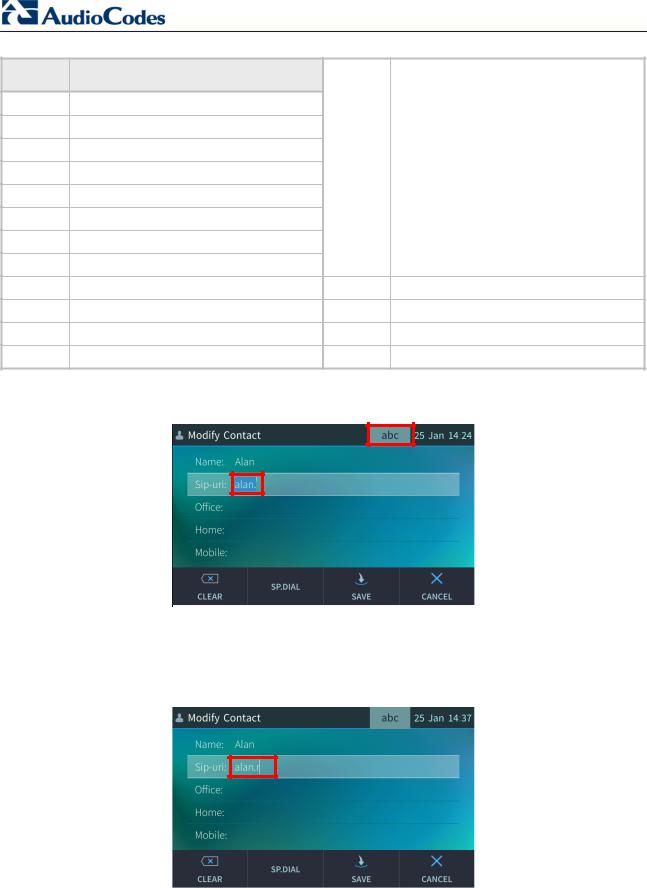
450HD IP Phone
Symbol Explanation
:Colon
#Pound
$ Dollar
%Percentage
^Caret
&Ampersand
! Exclamation mark
?Question mark
+Plus
-Hyphen
_ Underscore
~Approximates
Symbol |
Explanation |
|
|
|
|
) |
Close parenthesis |
|
|
|
|
{ |
Open parenthesis |
|
|
|
|
} |
Close parenthesis |
|
|
|
|
[ |
Open square parenthesis |
|
|
|
|
] |
Close square parenthesis |
|
|
|
|
" |
Double quotation marks |
|
|
|
|
' |
Single quotation mark |
|
|
|
|
> |
Greater than |
|
<Less than
,Comma
/Forward slash
Note that the asterisk (*) symbol is entered directly using the star key.
Figure 3-5: Entering a Symbol (e.g., a dot)
To revert to letters (e.g., abc):
Make sure the phone is in abc mode and successively press the PQRS key three times to produce r (for example):
Figure 3-6: Reverting to Letters (e.g., abc)
User's Manual |
26 |
Document #: LTRT-14820 |

User's Manual |
3. Getting Started |
3.5Signing In
This section shows how to sign in.
To sign in:
In the Offline screen, touch the Sign in softkey; the Sign-in options are displayed:
PIN code - see Section 3.5.1
User name and Password - see Section 3.5.2
Web - see Section 3.5.3
Note:
•After signing out, the next time you sign in the phone will present the option that was used to sign in before signing out.
•If a user signs out and another signs in, the phone presents empty Speed Dials and empty Call Logs to the newly signed-in user. The Speed Dials and Call Logs of the signed-out user are not saved on the phone.
3.5.1Signing in with PIN Code
This section shows how to sign in with the PIN code and phone number. The PIN code is provided by your network administrator.
To sign in with the PIN code:
1.In the 'Sign-in options' screen shown above, select the PIN Code option.
2.Enter your phone number.
3.Navigate down and enter your PIN code (obtainable from the network administrator). To switch from numbers to alphabetical letters and symbols, see Section 3.4.
Version 3.0.1 |
27 |
450HD IP Phone |

450HD IP Phone
4.Touch the Sign in softkey; after signing in successfully, the New Device Lock Code screen opens (see Section 4 for details).
3.5.2Signing in with User Name and Password
This section shows how to sign in with User Name and Password.
To sign in with User Name and Password:
1.In the 'Sign-in options' screen, select User name and Password.
Note: Signing in with a username that is a NetBIOS Domain Name, i.e., domain\username, or with the PIN Code, are disallowed for Skype for Business online sign-in. They are only allowed for on-premises sign-in. Online sign-in must be in the following format:
•Sign-in address, i.e., SIP URI. To switch from letters of the alphabet to symbols such as @, - and period, see Section 3.4.
•User name, in UPN (User Principal Name) format, i.e., the way the user's name appears in their e-mail address listed in the Active Directory: username@domain.com
•User’s network IT password (the same password you use to access your PC)
2.Touch the Sign in softkey; after signing in successfully, the New Device Lock Code screen opens (see Section 4 for details).
User's Manual |
28 |
Document #: LTRT-14820 |

User's Manual |
3. Getting Started |
3.5.3Signing in with the Cloud PBX Web Option
This section shows how to sign in with the Cloud PBX Web option, a.k.a. Device Pairing. Signing in with this option enables connectivity to Microsoft's Cloud PBX, Microsoft's cloud-hosted version of enterprise voice.
Note: Applies only to Microsoft Cloud PBX users using the 450HD phone.
The option exempts users from having to laboriously key in their user name and password using the phone keypad. If the option is selected, a URL and a Pairing Code are displayed:
Users must then point their browser to the URL and enter the Pairing Code in the Microsoft web page. Sign-in to Microsoft's Cloud PBX is then performed.
3.6Signing Out
This section shows how to sign out.
To sign out:
1.In the idle screen, touch the Status softkey.
2.In the Status screen touch the Sign out softkey.
You're signed out and returned to the idle screen displaying the Sign in softkey.
Version 3.0.1 |
29 |
450HD IP Phone |
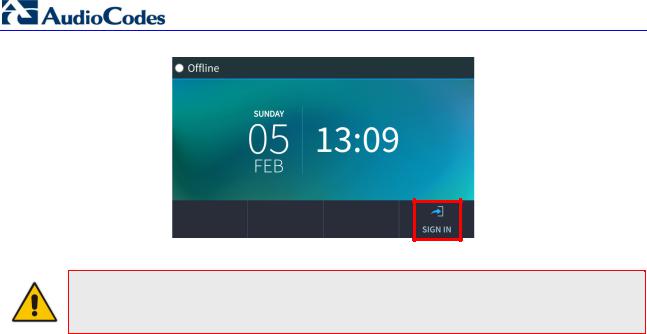
450HD IP Phone
Note: If a user signs out and another signs in, the phone presents empty Speed Dials and empty Call Logs to the newly signed in user. The Speed Dials and Call Logs of the signed out user are not saved on the phone.
User's Manual |
30 |
Document #: LTRT-14820 |
